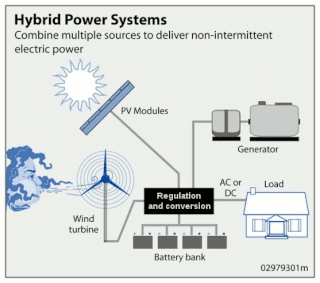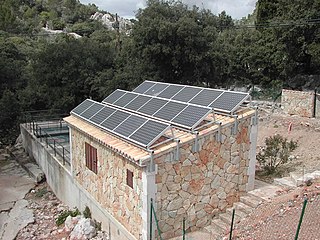
A stand-alone power system (SAPS or SPS), also known as remote area power supply (RAPS), is an off-the-grid electricity system for locations that are not fitted with an electricity distribution system. Typical SAPS include one or more methods of electricity generation, energy storage, and regulation.
Electricity is typically generated by one or more of the following methods:
- Photovoltaic system using solar panels
- Wind turbine
- Geothermal source
- Micro combined heat and power
- Micro hydro
- Diesel or biofuel generator
- Thermoelectric generator (TEGs)
Storage is typically implemented as a battery bank, but other solutions exist including fuel cells. Power drawn directly from the battery will be direct current extra-low voltage (DC ELV), and this is used especially for lighting as well as for DC appliances. An inverter is used to generate AC low voltage, which more typical appliances can be used with.

Stand-alone photovoltaic power systems are independent of the utility grid and may use solar panels only or may be used in conjunction with a diesel generator, a wind turbine or batteries.[1][2]
- ^ "Stand-Alone Photovoltaic Systems". renewable-energy-sources.com. Archived from the original on 2011-07-13. Retrieved 2011-07-21.
- ^ "A STAND-ALONE PHOTOVOLTAIC SYSTEM, CASE STUDY: A RESIDENCE IN GAZA" (PDF). trisanita.org. Archived from the original (PDF) on 2012-04-26. Retrieved 2011-07-21.